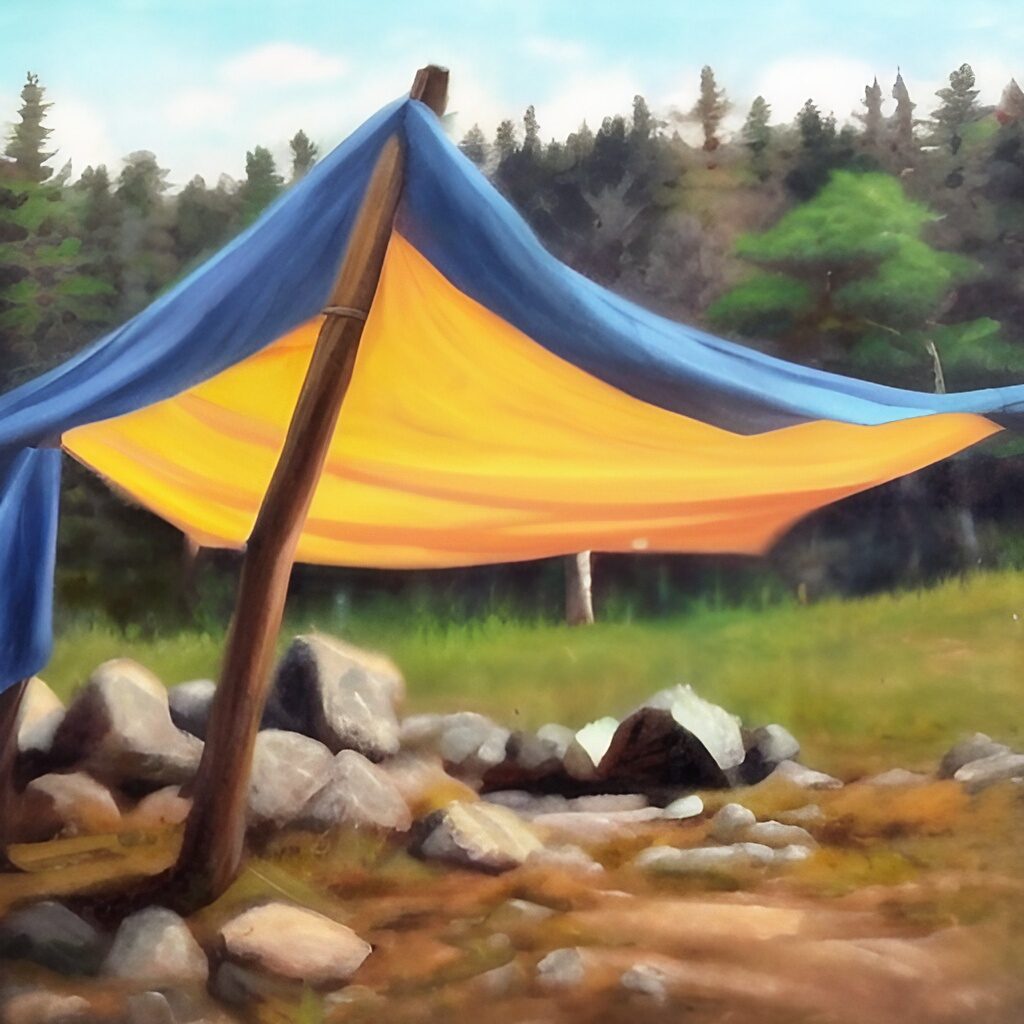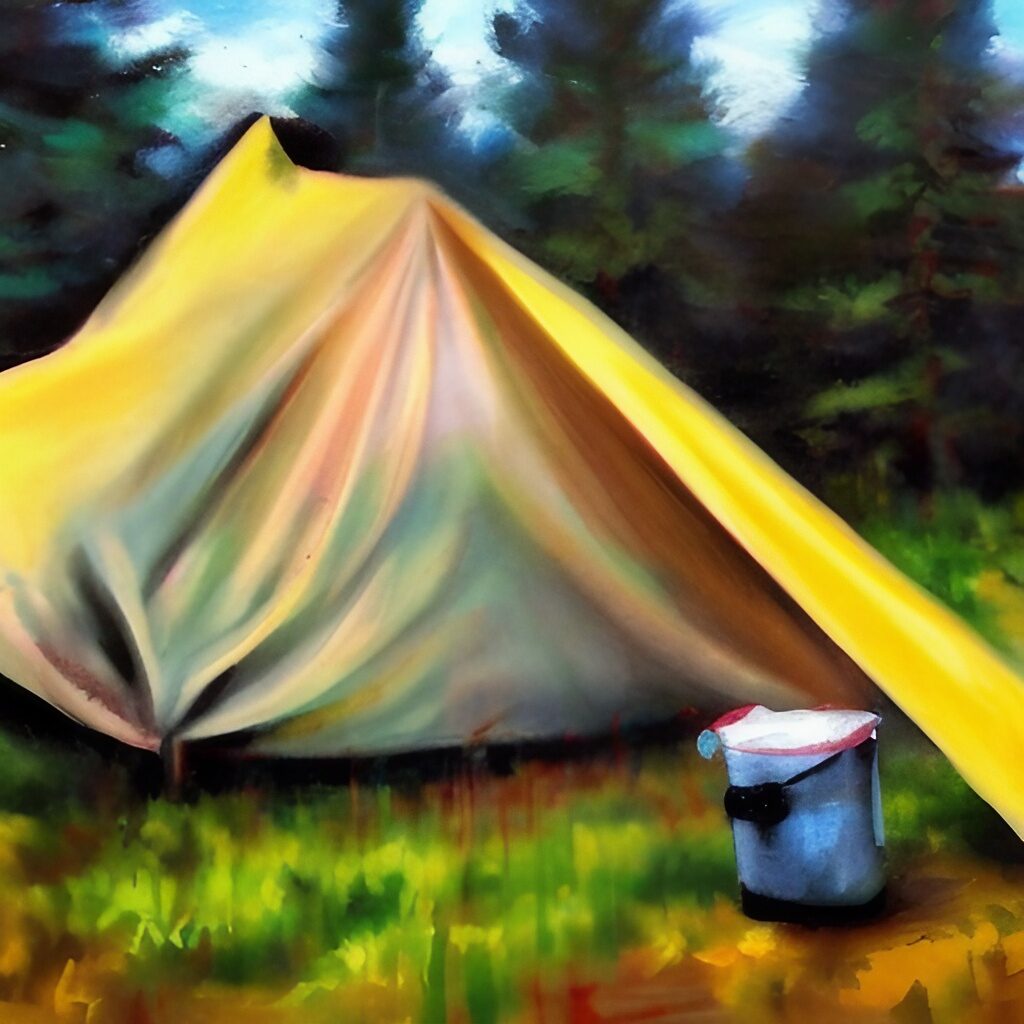
Tarps are incredibly useful pieces of camping gear. Use them to cover the ground, hang over you as additional shelter, and even as a windbreak.
Tarp Sizes – The average solo camper will need a tarp of a minimum of 6 by 8 square feet. If you want some additional shelter when you step outside your tent, then an 8 by 10 square-foot tarp is a good idea. In general, a tarp a foot larger than your tent would be a good fit.
There are lots of different scenarios where you might want to use a tarp when camping, so we’ve included detailed tables for matching tarp sizes in each situation.
- How Big Should a Tarp Be For Camping? – How Big Should Your Tarp Be?
- The Tarp Size You Should Use for Your Setup – How Big Should Your Tarp Be?
- The Best Tarp Size For Using A Tarp Under Your Setup – How Big Should Your Tarp Be?
- How To Use a Tarp as a Windbreak – How Big Should Your Tarp Be?
- Other Factors That Affect The Tarp Size You’ll Need – How Big Should Your Tarp Be?
- Mistakes to Avoid When Choosing Tarp Size – How Big Should Your Tarp Be?
- Conclusion – How Big Should Your Tarp Be?
- Frequently Asked Questions – How Big Should Your Tarp Be?
How Big Should a Tarp Be For Camping? – How Big Should Your Tarp Be?
In general, seasoned campers recommend a tarp at least 6 by 8 feet for a solo camper. A longer tarp of 8 by 10 feet works well for hammocking and bivy camping. Your tarp should be slightly larger than your tent, hammock, or another sleep setup.
As you can tell, there are lots of types of camping where you might need a tarp. The type of camping you’re doing will influence what size tarp you need—what you plan to do with your tarp also impacts what size will fit you best. For example:
- Car camping: You may wish to use your tarp as a ground cover, roof cover, or windbreak
- Backpacking: A tarp is often used over a bivy or sleeping bag instead of a tent
- Hammock: It’s common to put a tarp over your hammock to shield you from the elements
- Truckbed: You can sleep under a tarp in your truck bed, or you can use it as a floor in a truck bed tent
You’ll want to know what you plan to do with your tarp before you purchase one. If you purchase a tarp with sizing suitable for use under your tent, then you won’t have an easy time suspending it over your tent.
The Tarp Size You Should Use for Your Setup – How Big Should Your Tarp Be?
Before we get into this, you should know that there are lots of types of tarps that you can use for camping. You can see examples of some of them while exploring the best tarps for hammock camping.
Tarp size will vary depending on the style of the tarp, so let’s keep things consistent with a regular A-line square or rectangular tarp in this article. The KALINCO, shown below, is a good example of the type of tarp I mean.
The triangle shape is a great way to create a shelter in any of the scenarios above, but it can also be used flat on the ground.
Car Camping – The Tarp Size You Should Use for Your Setup
For car camping, you’ll typically be camping in a dome or cabin tent, and you’ll be using the tarp as an additional “roof” type of setup.
You not only need to account for the size of your tent, but you also need to account for the bend/crease in the roof of the tarp. The sloped angle of the sides will also make it seem smaller than it is.
This is why you need to select a tarp larger than your tent. One size larger is good enough, but if you’re going camping in rainy or stormy weather, then two sizes larger is a good call.
Tents vary in size depending on the brand, but I’ll select a common beginner brand when giving an example of tent and tarp sizes: Coleman.
Be sure to check the size of your tent and any new tent you’re buying, and match them to the sizes below when choosing your tarp.
| Tent Size | Tent Occupancy | Tarp Size |
| 7 x 5 feet | 2 people | 10 x 8 feet |
| 9 x 7 feet | 4 people | 10 x 10 feet |
| 10 x 10 feet | 6 people | 12 x 14 feet |
| 16 x 7 feet | 8 people | 14 x 20 feet |
Backpacking – The Tarp Size You Should Use for Your Setup
Your tarp doesn’t need to be quite as large when backpacking. You only have to cover yourself, not a tent.
A 6-by-9-foot tarp is commonly recommended if you’re looking for a rectangular tarp, and plenty of people do well with a 9-by-9-foot tarp.
However, this is for solo backpackers only. What about groups? You often won’t have a large enough clearing to set up lots of individual tarps, so it’s often best to get one larger tarp and line up under it to sleep. Let’s look at good tarp sizes for different numbers of backpackers.
| Backpackers | Tarp Size |
| 1 | 6 x 9 feet |
| 2 | 6 x 13 feet |
| 3 | 9 x 16 feet |
| 4 | 12 x 16 feet |
You’ll have to play with your sleeping setup to make the best use of your tarp size. For example, with a 12-by-16-foot tarp, you could fit three people side by side, and two people lying end-to-end horizontally below the side-by-side campers’ feet.
Hammock – The Tarp Size You Should Use for Your Setup
In most cases, your tarp should be as long and wide as your hammock. Getting something at least a foot wider than your hammock is a good idea, although focus more on width if you can’t find something long enough.
You won’t take up your entire hammock if you’re only 6 feet tall and your hammock is 10 feet long. So, if you only have a tarp that’s 8 feet long, you’ll be okay.
Hammocks come in lots of sizes, though, so here’s a table that’ll help you know what to look for when getting a tarp for your hammock:
| Hammock Length | Tarp Size |
| 9’10” x 6’6” | 12 x 10 feet |
| 9’ x 4’7” | 6 x 10 feet |
| 7’7” x 7’3” | 8 x 10 feet |
| 9’2” x 4’ | 6 x 10 feet |
The best thing you can do is find a size that works for you. Experiment with different tarp sizes to find the perfect fit. You may find that a tarp size feels too large or small for you, and that’s fine.
You can also experiment with different tarp positions like the camper below describes.
Truckbed – The Tarp Size You Should Use for Your Setup
Truckbed camping is the simplest to select a tarp for. Truck beds don’t vary in size a lot, and the most common truck bed size is 6’5” long. Getting a tarp at least 8 feet long will ensure you have full coverage.
You’ll need to measure your truck bed to figure out how wide it is, though. Many of them are around 4 feet wide.
An 8 by 6-foot tarp would work well for this, but your truck bed won’t always be the standard size.
The Best Tarp Size For Using A Tarp Under Your Setup – How Big Should Your Tarp Be?
You may also wish to use a tarp under your sleeping setup. In fact, “do I need a tarp under my tent?” is a common question that new campers and seasoned campers alike ask.
Hammock camping doesn’t apply here, as you won’t be on the ground, but tarps are commonly used under tents, for backpacking, and while truckbed camping.
Let’s examine what sizes are common.
Car Camping – The Best Tarp Size For Using A Tarp Under Your Setup
For car camping, a tarp that’s slightly larger than your tent will be the best fit. Here’s a table with some common tent sizes and tarp sizes for those tents:
| Tent Size | Tarp Size in Feet |
| 2-Person | 7 x 5 |
| 3-Person | 7 x 7 |
| 4 to 5-Person | 6 x 8 |
| 6-Person | 10 x 10 |
You don’t have to be as rigid with your tarp size if you’re using it under your tent, as you can always fold up any extra material. That’s not possible when using a tarp over your tent.
However, always remember that a little bigger is better than a little too small—you won’t be able to utilize a tarp that’s too small.
Going too big isn’t good either, though. That leads to pooling, explained in detail in the article linked above. Basically, pooling leaves your tent surrounded by water and defeats the purpose of using a tarp.
Backpacking – The Best Tarp Size For Using A Tarp Under Your Setup
You won’t need a huge tarp to go under you while you’re backpacking. You just need something at least as wide as your shoulders, and a little taller than you.
So, if you’re 6 feet tall, then a tarp 7 feet or longer will work. As for width, the average adult male has a shoulder width of under 2 feet, so something 3 feet wide or larger for any person should fit well.
Your tarp can be much wider than you—you won’t have any problems. But you’re going to want something as compact as possible while you’re backpacking.
Tarps that are 4 by 8 feet aren’t common, but if you can find one, then it’s a great size for a solo backpacker!
I recommend another 3–4 feet of width per additional backpacker who’ll be sleeping on the tarp. You may have to size up length-wise too, though, as tarp sizes often increase by both width and length.
Truckbed – The Best Tarp Size For Using A Tarp Under Your Setup
You’ll have to measure your truckbed to find out how large it is, but a tarp that fits its measurements will work well.
It doesn’t matter if you get a tarp that’s too big for your truck bed. It’s easy to fold in the extra material. You can also leave excess material to hang over the size of the bed, if possible.
Try putting tarps of different sizes into your truck bed and see what works best for you. Truck beds often have different protruding parts in them—like storage containers—so these will influence how well your tarp fits. Experimenting is the best option, in most cases!
How To Use a Tarp as a Windbreak – How Big Should Your Tarp Be?
Ensure your windbreak is wide enough to block any breezes that blow in your direction. You’ll need to have string or guylines to suspend your tarp so that at least part of it remains vertical. Peg the ground-laying portion of the tarp so it doesn’t flap in the wind.
This windbreak will help keep harsh winds away from your campsite if there are no trees or bushes to create one naturally. You can utilize a tarp to shield you from the wind.
You’ll need to be familiar with your camping spot in advance, though, as you’ll have to measure it to figure out what size tarp you need.
Make sure you don’t use a tarp that’s too small, as that may create two additional channels for the wind to blow through on either side of the tarp. Using an oversized tarp is better than using one that’s undersized.
A second way to create a windbreak is to suspend a guyline or rope from tree to tree, then place your tarp on top with the corners meeting near the ground. Peg/stake these corners down so the tarp doesn’t flap.
Using part of the tarp as an overhead shelter is another idea you could try—there are plenty of ways to create a windbreak that works for you.
Other Factors That Affect The Tarp Size You’ll Need – How Big Should Your Tarp Be?
Unfortunately, selecting a tarp the right size isn’t as simple as you think. There are a few things you need to be careful about when selecting your tarp.
Tarp Design – Other Factors That Affect the Tarp Size You’ll Need
As I said, all of the suggestions above are for A-frame tarps or tarps that can be made into A-frame tarps. However, they’re not your only option.
You may want a flat square over your tent, and that’s fine. You won’t need a tarp that’s quite as large, as there won’t be a bend or slope to it.
There are also tarps that are shaped like a tent and have little doors flaps. There are tarps with lots of corners that you stake to the ground. The possibilities are endless.
Pay attention to what tarp size you need, as the design is vital when you’re trying to select the right size.
Finished vs Cut Size – Other Factors That Affect the Tarp Size You’ll Need
Sometimes you’ll buy a tarp that’s smaller than you expected. This is because the finished and cut sizes differ.
Your tarp’s cut size is how large the tarp is before the hems, seams, and eyelets were added. Your tarp’s finished size will be a few inches smaller than this.
If you’re buying a tarp, make sure the size advertised is the cut size, not the finished size. If the manufacturer only states the cut size, then get a tarp a few inches bigger than it.
Weather Conditions – Other Factors That Affect the Tarp Size You’ll Need
If you’re positioning your tarp over you or your tent, you’re going to need some ventilation to keep condensation at bay and stop you from being too warm.
In winter. you want to keep as much heat in as possible, so you’ll want your tarp tight to the sides of the tent and as close to the ground as you can get it. You still need a little gap between the tarp and the tent to try and keep condensation at bay.
Summer is warmer, so the gap between the tarp and the ground can be larger, and the tarp doesn’t have to be as tight to you/your tent.
Mistakes to Avoid When Choosing Tarp Size – How Big Should Your Tarp Be?
There are a few other factors you should consider when buying a tarp, so let’s go over them before you head off on your tarp shopping spree.
Choosing Too Small – Mistakes to Avoid When Choosing Tarp Size
It’s tempting to choose the smallest tarp possible to cut costs, but getting a larger one is better because of weather and positioning considerations.
A smaller tarp size can work in summer, as it’ll mostly be used as a sun shelter, but a larger tarp is better in winter so any potential rain and snow can hit the tarp, slide down, and land away from you.
Ignoring Ventilation – Mistakes to Avoid When Choosing Tarp Size
Experimenting with different tarp sizes is good when you’re trying to figure out your ventilation setup.
On the one hand, a large tarp has sides long enough to meet the ground in a low-ventilation setup. However, you also need it to be high enough above your setup so it’s not closing in on you too much.
If you want more ventilation, then place your tarp higher above your tent. For this, you’ll need a tarp with sides long enough to cover your tent fully despite being further away/higher up.
This is why experimentation is crucial. Work with your tarps until you find the tarp size and position that gives you what you want.
Material – Mistakes to Avoid When Choosing Tarp Size
If you’re backpacking, try to avoid canvas tarps. They’re large and heavy, and they won’t be pleasant to travel with. Hydrophobic tarps, which are synthetic and often made from polyester blends, are best.
Hydrophobic tarps are also waterproof, so they’ll be much easier to dry after rain.
Ease of Storage – Mistakes to Avoid When Choosing Tarp Size
Another reason to get a hydrophobic tarp is that it’ll be easier to store. They can roll or fold up decently small.
Car campers don’t need to worry about this too much, but backpackers and hammock campers will want to find something that stores compactly. Keep this in mind when shopping for your tarp.

Conclusion – How Big Should Your Tarp Be?
Bigger is always better when choosing tarp size, but going too big isn’t good, either. Ensure you know exactly what size you need before buying something, and always try to buy something that you can return if it doesn’t fit.
Lots of basic tarps aren’t too pricey, so consider getting a few sizes and experimenting to find which one works best. Return the ones that don’t fit, and you’re sure to find the perfect tarp.
Frequently Asked Questions – How Big Should Your Tarp Be?
What Should Different Tarp Materials be Used For? – FAQs
Tarps, also known as tarpaulins, are versatile and long-lasting sheets of material used for a variety of purposes.
Tarps are commonly made from a variety of materials, each with its own set of unique properties and benefits:
- Polyethylene tarps are the most commonly used type of tarp and are frequently used for general-purpose applications such as covering outdoor furniture or protecting surfaces during painting or construction projects. They are lightweight, waterproof, and UV-resistant.
- Canvas tarps are heavier and more durable than polyethylene tarps, making them ideal for use in harsh outdoor conditions. They provide excellent wind, rain, and sun protection, making them popular for camping trips and other outdoor activities.
- Vinyl tarps are extremely strong and tear-resistant, making them an excellent choice for heavy-duty applications like truck covers or boat covers. They also provide excellent UV protection and can be used in extreme weather conditions.
- Mesh tarps are intended to allow airflow while still providing some protection from the elements. They are frequently used in agricultural settings to shield crops from direct sunlight or insects.
Tarps are used for a variety of purposes, including covering objects during transportation or storage, protecting surfaces during construction or painting projects, constructing temporary shelters or tents, and a variety of other applications requiring temporary coverage.
What are Some Stores that Sell Tarps? – FAQs
Tarps can be purchased from a variety of stores, both online and in person.
Tarps can be found in a variety of places, including:
- Home Depot: A popular home improvement store, Home Depot carries a wide variety of tarps for various applications, including heavy-duty vinyl tarps, canvas tarps, and polyethylene tarps.
- Lowe’s: Another home improvement store that sells tarps in a variety of sizes and materials is Lowe’s. They have small polyethylene tarps to large canvas tarps for outdoor use.
- Walmart: Walmart is a retail behemoth that carries a wide range of products, including tarps. They offer a wide range of sizes and materials at reasonable prices.
- Amazon: Amazon is the world’s largest online retailer, and they have a massive selection of tarps for sale. On Amazon, you can find almost any type of tarp, from small polyethylene tarps to large truck covers.
- Northern Tool + Equipment: Northern Tool + Equipment is a specialty retailer that specializes in industrial and outdoor tools and equipment. They sell high-quality tarps in a variety of sizes and materials, such as heavy-duty vinyl and mesh.
These are just a few examples of stores that sell tarps. Other local retailers or specialty shops may sell them as well, depending on where you live.
How Can I Make an Emergency Shelter Out of a Tarp? – FAQs
Tarps can be used to quickly and easily construct an emergency shelter in a variety of situations.
The following are the fundamental steps for constructing a tarp shelter:
- Locate a suitable location: Look for a flat, dry area free of hazards such as rocks or sharp objects.
- Select your tarp: Choose a tarp large enough to cover the area where you intend to set up your shelter. Typically, a 10′ x 10′ square or rectangular tarp will suffice.
- Tie one end of the tarp to a tree or other sturdy object: This will serve as the anchor point for your shelter.
- Place a stake in the opposite corner of the tarp: To secure this corner of the tarp to the ground, use tent stakes or heavy objects such as rocks or logs.
- Rep with the remaining two corners: Stake down the tarp’s remaining corners to create tension and keep it in place.
- As needed, make the following changes: After you’ve secured all four corners, adjust the tension on each side of the tarp until it’s tight and secure.
- Add additional support if necessary: If you need additional protection from wind or rain, consider adding additional stakes or tying guidelines to nearby trees or other objects to provide additional support for your shelter.
Remember that, while tarps can be an effective way to create emergency shelters, they may not provide complete protection in severe weather. If you are unsure about how to properly set up a shelter in an emergency, always exercise caution and seek professional assistance.















